United Microelectronics Corp (UMC, 聯電) yesterday reported record net profit for last quarter, saying that it expects revenue to remain little changed this quarter, as robust demand for chips used in vehicles, servers and industrial devices would help offset weakness in smartphones, TVs and PCs.
Overall factory utilization including 8-inch fabs would be at full capacity this quarter and stay at a healthy level next quarter, the world’s third-largest foundry service provider said.
Wafer prices would remain “firm” through the second half of this year, following seven straight quarters of price increases, UMC said.

Photo: Grace Hung, Taipei Times
The company is confident that it will reach its revenue growth target this year, as it aims to grow its revenue at least on par with the foundry industry’s annual revenue growth rate of more than 20 percent, UMC president Jason Wang (王石) told investors during a conference call yesterday.
“While we observe soft demand in smartphones, notebook computers and consumer electronics, other segments such as networking, industrial and automotive have stable demand,” Wang said.
UMC said customers have become “conservative in general” and inventory levels are relatively high in certain segments.
Wang said that the semiconductor industry is undergoing an inventory correction-driven downturn following two years of upcycles.
To digest excessive inventory, a minimal number of customers faced penalty payments as they failed to fully honor their long-term supply agreements with UMC, Wang said.
However, the number of such agreements is still on the rise for UMC’s new capacity in Singapore, he said.
The chipmaker has no plans to cut its capital expenditure because of the short-term industry headwinds, Wang said.
UMC is planning to spend US$3.6 billion on new facilities and equipment this year.
The spending would mostly be used to fund the construction of a new manufacturing facility in Tainan, dubbed P6, in preparation for the start of mass production in June next year.
The facility would add about 5 percent to UMC’s capacity next year, it said.
Deploying 14-nanometer capacity would not be less of a priority for UMC, Wang said.
UMC’s 22-nanometer and 28-nanometer technologies are the most advanced that the company offers, accounting for 22 percent of its total revenue last quarter.
For this quarter, UMC expects wafer shipments to be flat from last quarter.
Gross margin would drop to about 45 percent this quarter from 46.5 percent last quarter, it said.
Net profit last quarter soared 78.6 percent year-on-year to NT$21.33 billion (US$712.6 million) from NT$11.94 billion in the same period last year, benefiting from strong demand across all end markets.
On a quarterly basis, net profit increased 7.7 percent from NT$19.81 billion.
Earnings per share rose to NT$1.74 last quarter, from NT$0.98 a year earlier and NT$1.61 in the previous quarter.

Semiconductor business between Taiwan and the US is a “win-win” model for both sides given the high level of complementarity, the government said yesterday responding to tariff threats from US President Donald Trump. Home to the world’s largest contract chipmaker, Taiwan Semiconductor Manufacturing Co (TSMC, 台積電), Taiwan is a key link in the global technology supply chain for companies such as Apple Inc and Nvidia Corp. Trump said on Monday he plans to impose tariffs on imported chips, pharmaceuticals and steel in an effort to get the producers to make them in the US. “Taiwan and the US semiconductor and other technology industries

SMALL AND EFFICIENT: The Chinese AI app’s initial success has spurred worries in the US that its tech giants’ massive AI spending needs re-evaluation, a market strategist said Chinese artificial intelligence (AI) start-up DeepSeek’s (深度求索) eponymous AI assistant rocketed to the top of Apple Inc’s iPhone download charts, stirring doubts in Silicon Valley about the strength of the US’ technological dominance. The app’s underlying AI model is widely seen as competitive with OpenAI and Meta Platforms Inc’s latest. Its claim that it cost much less to train and develop triggered share moves across Asia’s supply chain. Chinese tech firms linked to DeepSeek, such as Iflytek Co (科大訊飛), surged yesterday, while chipmaking tool makers like Advantest Corp slumped on the potential threat to demand for Nvidia Corp’s AI accelerators. US stock

The US Federal Reserve is expected to announce a pause in rate cuts on Wednesday, as policymakers look to continue tackling inflation under close and vocal scrutiny from US President Donald Trump. The Fed cut its key lending rate by a full percentage point in the final four months of last year and indicated it would move more cautiously going forward amid an uptick in inflation away from its long-term target of 2 percent. “I think they will do nothing, and I think they should do nothing,” Federal Reserve Bank of St Louis former president Jim Bullard said. “I think the

SUBSIDIES: The nominee for commerce secretary indicated the Trump administration wants to put its stamp on the plan, but not unravel it entirely US President Donald Trump’s pick to lead the agency in charge of a US$52 billion semiconductor subsidy program declined to give it unqualified support, raising questions about the disbursement of funds to companies like Intel Corp and Taiwan Semiconductor Manufacturing Co (台積電). “I can’t say that I can honor something I haven’t read,” Howard Lutnick, Trump’s nominee for commerce secretary, said of the binding CHIPS and Science Act awards in a confirmation hearing on Wednesday. “To the extent monies have been disbursed, I would commit to rigorously enforcing documents that have been signed by those companies to make sure we get